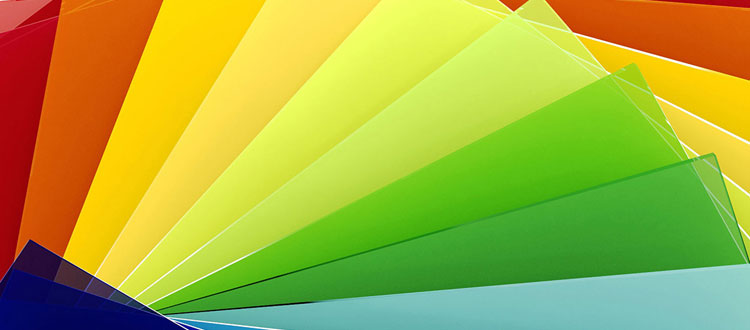WORKING WITH ACRYLITE® ACRYLIC SHEETS
Certain factors need to be considered when working, storing, or cleaning ACRYLITE Acrylic Sheets. Please read more about this here.
STORAGE
ACRYLITE® acrylic sheets are protected with paper or polyethylene masking on both sides. Sheet should be stored vertically, preferably in a rack where the sheet can be fully supported and can lean at approximately a 10 degree angle.
If acrylic sheet is stacked horizontally, it must not be allowed to sag. Take care to prevent debris or dirt from becoming lodged between the sheet as the weight of the material can force debris through the protective masking and damage the sheet. If various sizes are stacked horizontally, the larger sheet should be at the bottom to avoid an unsupported overhang.
ACRYLITE® sheet should not be stored near radiators or steam pipes, in sunlight or near other heat sources, as excessive heat tends to soften and deform the sheet.
PREPARATION OF WORK AREA
It is very important to find a clean, dust-free work area. Cover the work table with a soft, clean, lint-free felt. When the protective masking is removed from the acrylic sheets, it will generate a static charge on the sheet surface. This charge will attract dirt and lint from other nearby surfaces.
To prevent scratching during handling, leave the protective masking on the sheet as long as possible.
SCRIBING AND BREAKING – HOW TO CUT ACRYLIC SHEETS
This method is useful for quick, straight line cutting of short lengths. Lay the masked sheet on a flat surface and mark the line to be scribed (scored). The paper masking can be marked with almost any writing tool including pencil, ball point pens, and felt tip pens for cutting purposes. Use a straight edge held firmly in place to guide the scriber, knife, or glass cutter along the line. Scribe the sheet several times with firm even pressure along the same line.
Next, position the sheet so that the scribed line is just beyond the edge of the working surface. While holding the sheet firmly in place on the working surface near the scribed line, apply a sharp downward pressure to the end of the sheet overhanging the surface edge.
This will cause the sheet to break along the scribed line.
Scribing tools made specifically for acrylic can be purchased from most local plastics distributors and are also available from the Fletcher-Terry Company. These cutters utilize the “scribe and break” principle for cutting acrylic sheets. For additional details, call Fletcher-Terry direct at (888) 883-6165 or visit www.fletcherviscom.com.
REMOVAL OF MASKING
To remove the masking, lift one corner, then pull toward the opposite end of the sheet slowly and evenly. The masking should never be exposed to excessive sunlight or outdoor conditions for extended periods of time.
The removal of old or difficult to remove masking can sometimes be assisted by dampening the masking with aliphatic naphtha, kerosene, or hexane. Afterwards the acrylic sheet should be thoroughly washed with mild soap and water and then rinsed again with clean water to remove any residues. When using these solvents, care should be taken to observe the safe handling procedures recommended by the solvent manufacturer and to protect other framing materials or framed items from possible damage. Avoid use of gasoline and sharp-edged objects such as razor blades.
HOW TO CLEAN ACRYLIC SHEETS
Should you need to clean the acrylic sheet, use a clean, damp cleaning cloth, such as the 3M® Scotch-Brite® High Performance Cleaning Cloth. Apply only light pressure, rinse with clean water, and dry by blotting with a damp cloth or chamois.
Dust the picture glazing with a soft, damp cloth or chamois. Dry or gritty cloths may cause surface scratches and create a static electric charge on the surface. Evonik’s line of ACRIFIX™ acrylic sheet cleaners and anti-static polishes can be purchased at www.acrylite-shop.com. For more information on ACRIFIX™ products, visit www.acrifix.com.
Do not use window cleaning sprays, kitchen scouring compounds, or solvents such as acetone, gasoline, or lacquer thinner to clean acrylic sheets.
The exception is ACRYLITE® abrasion resistant acrylic sheet. It’s proprietary abrasion resistant coating permits use of common household cleaners such as: Fantastik®, Glass Plus®, Formula 409®, Mr. Clean®, and Windex®. If the sheet is not coated on both sides, care should be taken during the cleaning process to prevent cleaners from contacting the uncoated side or edges of the sheet.
REMOVING SCRATCHES
Fine scratches can be removed by hand polishing with an acrylic polish or paste wax. Apply polish to a soft cloth and rub. When the scratches have disappeared, remove all residue and polish.
STATIC CONTROL
There are a number of commercially available plastic cleaners that provide temporary static reduction. Evonik’s line of ACRIFIX™ acrylic cleaners and anti-static polishes can be purchased at www.acrylite-shop.com. For more information on ACRIFIX™ products, visit www.acrifix.com.
Washing the sheet with mild soap and water followed by a thorough rinse with clean water will also remove static charge. When drying the sheet, it is essential that the sheet be lightly blotted with a damp cloth. Rubbing with a dry cloth will generate static charge and could scratch the sheet.
The most effective way to remove static charge from acrylic sheets is to blow deionized air on the sheet surface. Deionized air can be produced by attaching a deionizing air gun (available from SIMCO CO., Inc. (800) 203-3419) to a compressed air hose. A clean, filtered supply of compressed air must be used. Static charge and dirt or chips will be quickly and easily removed by the deionized air stream. The effects of deionized air are only temporary. Handling may, over time, cause the sheet to pick up additional static charge.
Architectural Plastics, Inc, have researched and developed superior methods to design and fabricate any acrylic product, including displays, furniture and cases. Give Architectural Plastics, Inc a call today.





